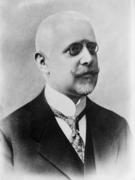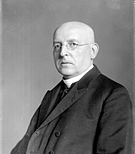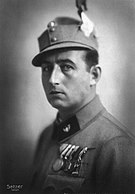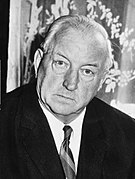List of Chancellors of Austria
- Renner was the first chancellor of German-Austria, the First Republic, and the Second Republic.
- Dollfuss turned the First Republic into a dictatorship.
- Bierlein was Austria's first female Chancellor.
- Kreisky is considered perhaps Austria's most successful Socialist leader and also the longest serving Chancellor.[1]
The chancellor of Austria is the head of government of Austria, appointed by the president and viewed as the country's de facto chief executive. The chancellor chairs and leads the Cabinet, which also includes the vice-chancellor and the ministers.[2]
Following World War I, the office was established by the Provisional National Assembly on 30 October 1918 and named state chancellor of the Republic of German-Austria, and its first holder, Karl Renner, was appointed by the State Council. After the Allied powers forbade German-Austria to merge with the Weimar Republic,[3] the country formed the federal First Austrian Republic and the office was renamed from state chancellor to federal chancellor. The first federal chancellor was Michael Mayr. Ten chancellors served under the First Republic until Chancellor Engelbert Dollfuss created the authoritarian and dictatorial Federal State of Austria.[4] Following Dollfuss's assassination by Austrian National Socialists,[5] Kurt Schuschnigg succeeded him as chancellor and upheld the dictatorship.[6] Schuschnigg was replaced by Arthur Seyss-Inquart, a Nazi caretaker who held the office for two days, until Austria was annexed into Nazi Germany.[7]
Austria under National Socialism lost its original republican system of government and was administered by Reichsstatthalter Arthur Seyss-Inquart (1938–1939), Reichskommissar Josef Bürckel[8] (1939–1940), and Reichsstatthalter Baldur von Schirach[9] (1940–1945). In 1940, the country was renamed Ostmark, completely lost its autonomy, and became a sub-national division of Nazi Germany.[10][11] After the liberation of Vienna and the capitulation of Nazi Germany in 1945, Austria restored its republican form of government.[12] However, Austria remained under allied occupation until 1955[13] and thus the country's sovereignty was ultimately still held by the Allied Control Council.
Since the institution of the republic, the People's Party and the Social Democratic Party have largely dominated Austrian politics; the People's Party (and its predecessor, the Christian Social Party) have led nineteen cabinets and served as a junior partner in eight, while the Social Democratic Party (formerly the Social Democratic Workers' Party) has led eleven and served as a junior partner in five. There have been seven parties that never held the chancellorship but participated in coalition cabinets: the Greater German People's Party in five, the Freedom Party and the Landbund in four, the Fatherland Front in two, and the Greens, the Alliance for the Future, and the Communist Party in one.
Following a legislative election or in the case of a vacancy, the president conventionally picks the leader of the largest party in Parliament to serve as chancellor, and appoints the remaining members of the Cabinet based on the chancellor's recommendation. If a sitting chancellor dies, resigns, or is otherwise unable to exercise the powers and duties of the office, the vice-chancellor becomes acting chancellor. If the vice-chancellor is unavailable, the other members of the Cabinet take over in order of seniority.[14]
Bruno Kreisky was the longest-serving chancellor, with more than thirteen years in office, while Arthur Seyss-Inquart was the shortest-serving chancellor, with two days in office, and Walter Breisky was the shortest-serving acting chancellor, with only one day in office.
Chancellors
Key to parties
| |||
|---|---|---|---|
|
|
||
Key to historical parties
| |||
|---|---|---|---|
1922–1934: Rural Federation / Landbund (LBd)
1920–1936: Homeland Guard / Heimwehr
|
1920–1945: National Socialist German Worker's Party / Nationalsozialistische Deutsche Arbeiterpartei (NSDAP)
| ||
| No. | Portrait | Name (born–died) |
Term of office | Party | Elected | Cabinet coalition |
Ref. | |||
|---|---|---|---|---|---|---|---|---|---|---|
| Took office | Left office | Time in office | ||||||||
| 1 | 
|
Karl Renner[a][b] (1870–1950) |
30 October 1918 | 7 July 1920 | 1 year, 251 days | SDAPÖ | 1919 | Renner I–II–III • SDAPÖ • CS • GDVP |
[15][16][17] | |
| 2 | 
|
Michael Mayr[c] (1864–1922) |
7 July 1920 | 21 June 1921 | 349 days | CS | 1920 | Mayr I–II • CS • SDAPÖ |
[18] | |
| 3 | 
|
Johannes Schober (1874–1932) |
21 June 1921 | 26 January 1922 | 344 days | IND | – | Schober I • CS • GDVP • Technocrats |
[19] | |
| 4 | 
|
Walter Breisky (1871–1944) |
26 January 1922 | 27 January 1922 | 1 day | CS | – | Breisky • CS • GDVP |
[20] | |
| (3) | 
|
Johannes Schober (1874–1932) |
27 January 1922 | 31 May 1922 | 124 days | IND | – | Schober II • CS • GDVP • Technocrats |
[21] | |
| 5 | 
|
Ignaz Seipel (1876–1932) |
31 May 1922 | 20 November 1924 | 2 years, 173 days | CS | 1923 | Seipel I–II–III • CS • GDVP • Technocrats |
[22] | |
| 6 | 
|
Rudolf Ramek (1881–1941) |
20 November 1924 | 20 October 1926 | 1 year, 334 days | CS | – | Ramek I–II • CS • GDVP |
[23] | |
| (5) | 
|
Ignaz Seipel (1876–1932) |
20 October 1926 | 4 May 1929 | 2 years, 196 days | CS | 1927 | Seipel IV–V • CS • GDVP • LBd |
[citation needed] | |
| 7 | 
|
Ernst Streeruwitz (1874–1952) |
4 May 1929 | 26 September 1929 | 145 days | CS | – | Streeruwitz • CS • LBd |
[24] | |
| (3) | 
|
Johannes Schober (1874–1932) |
26 September 1929 | 30 September 1930 | 1 year, 4 days | IND | – | Schober III • CS |
[citation needed] | |
| 8 | 
|
Carl Vaugoin (1873–1949) |
30 September 1930 | 4 December 1930 | 65 days | CS | – | Vaugoin • CS |
[25] | |
| 9 | 
|
Otto Ender (1875–1960) |
4 December 1930 | 20 June 1931 | 198 days | CS | 1930 | Ender • CS |
[26] | |
| 10 | 
|
Karl Buresch (1878–1936) |
20 June 1931 | 20 May 1932 | 335 days | CS | – | Buresch I–II • CS • LBd |
[27] | |
| 11 | 
|
Engelbert Dollfuss (1892–1934) |
20 May 1932 | 25 July 1934 † | 2 years, 66 days | CS | – | Dollfuss I • CS • LBd • Heimwehr 20 May 1932 – 1 May 1934 Dollfuss II • VF 1 May 1934 – 25 July 1934 |
[28] | |
| VF | ||||||||||
| – | 
|
Prince Ernst Rüdiger Starhemberg (1899–1956) ‡ |
25 July 1934 | 29 July 1934 | 4 days | VF | – | Dollfuss II • VF |
[29] | |
| 12 | 
|
Kurt Schuschnigg (1897–1977) |
29 July 1934 | 11 March 1938 | 3 years, 225 days | VF | – | Schuschnigg I–II–III–IV–V • VF |
[30] | |
| 13 | 
|
Arthur Seyss-Inquart (1892–1946) |
11 March 1938 | 13 March 1938 | 2 days | NSDAP | – | Seyss-Inquart • NSDAP |
[31][32] | |
| Austria was part of Nazi Germany from 13 March 1938 to 27 April 1945 | ||||||||||
| (1) | 
|
Karl Renner[d] (1870–1950) |
27 April 1945 | 20 December 1945 | 237 days | SPÖ | – | Renner IV • SPÖ • ÖVP • KPÖ |
[33][34][35] | |
| 14 | 
|
Leopold Figl (1902–1965) |
20 December 1945 | 2 April 1953 | 7 years, 103 days | ÖVP | 1945 | Figl I–II–III • ÖVP • SPÖ |
[36] | |
| 1949 | ||||||||||
| 15 | 
|
Julius Raab (1891–1964) |
2 April 1953 | 11 April 1961 | 8 years, 9 days | ÖVP | 1953 | Raab I–II–III–IV • ÖVP • SPÖ |
[37] | |
| 1956 | ||||||||||
| 1959 | ||||||||||
| 16 | 
|
Alfons Gorbach (1898–1972) |
11 April 1961 | 2 April 1964 | 2 years, 357 days | ÖVP | 1962 | Gorbach I–II • ÖVP • SPÖ |
[38] | |
| 17 | 
|
Josef Klaus (1910–2001) |
2 April 1964 | 21 April 1970 | 6 years, 19 days | ÖVP | – | Klaus I • ÖVP • SPÖ |
[39] | |
| 1966 | Klaus II • ÖVP | |||||||||
| 18 | 
|
Bruno Kreisky (1911–1990) |
21 April 1970 | 24 May 1983 | 13 years, 33 days | SPÖ | 1970 | Kreisky I–II–III–IV • SPÖ |
[40] | |
| 1971 | ||||||||||
| 1975 | ||||||||||
| 1979 | ||||||||||
| 19 | 
|
Fred Sinowatz (1929–2008) |
24 May 1983 | 16 June 1986 | 3 years, 23 days | SPÖ | 1983 | Sinowatz • SPÖ • FPÖ |
[41] | |
| 20 | 
|
Franz Vranitzky (born 1937) |
16 June 1986 | 28 January 1997 | 10 years, 226 days | SPÖ | 1986 | Vranitzky I–II • SPÖ • FPÖ |
[42] | |
| 1990 | Vranitzky III–IV–V • SPÖ • ÖVP | |||||||||
| 1994 | ||||||||||
| 1995 | ||||||||||
| 21 | 
|
Viktor Klima (born 1947) |
28 January 1997 | 4 February 2000 | 3 years, 7 days | SPÖ | – | Klima • SPÖ • ÖVP |
[43] | |
| 22 | 
|
Wolfgang Schüssel (born 1945) |
4 February 2000 | 11 January 2007 | 6 years, 341 days | ÖVP | 1999 | Schüssel I • ÖVP • FPÖ 4 February 2000 – 3 April 2005 Schüssel II • ÖVP • BZÖ 3 April 2005 – 11 January 2007 |
[44] | |
| 2002 | ||||||||||
| 23 | 
|
Alfred Gusenbauer (born 1960) |
11 January 2007 | 2 December 2008 | 1 year, 326 days | SPÖ | 2006 | Gusenbauer • SPÖ • ÖVP |
[45] | |
| 24 | 
|
Werner Faymann (born 1960) |
2 December 2008 | 9 May 2016 | 7 years, 159 days | SPÖ | 2008 | Faymann I–II • SPÖ • ÖVP |
[46] | |
| 2013 | ||||||||||
| – | 
|
Reinhold Mitterlehner (born 1955) ‡ |
9 May 2016 | 17 May 2016 | 8 days | ÖVP | – | Faymann II • SPÖ • ÖVP |
[47][48] | |
| 25 | 
|
Christian Kern (born 1966) |
17 May 2016 | 18 December 2017 | 1 year, 215 days | SPÖ | – | Kern • SPÖ • ÖVP |
[49] | |
| 26 | 
|
Sebastian Kurz (born 1986) |
18 December 2017 | 28 May 2019 | 1 year, 161 days | ÖVP | 2017 | Kurz I • ÖVP • FPÖ 18 December 2017 – 22 May 2019 • ÖVP 22 May 2019 – 28 May 2019 |
[50] | |
| – | 
|
Hartwig Löger (born 1965) ‡ |
28 May 2019 | 3 June 2019 | 6 days | ÖVP | – | Kurz I • ÖVP |
[51][52] | |
| 27 | 
|
Brigitte Bierlein (1949–2024) |
3 June 2019 | 7 January 2020 | 218 days | IND | – | Bierlein • Technocrats |
[53][54] | |
| (26) | 
|
Sebastian Kurz (born 1986) |
7 January 2020 | 11 October 2021 | 1 year, 277 days | ÖVP | 2019 | Kurz II • ÖVP • Greens |
[55] | |
| 28 | 
|
Alexander Schallenberg (born 1969) |
11 October 2021 | 6 December 2021 | 56 days | ÖVP | – | Schallenberg • ÖVP • Greens |
[56] | |
| 29 | 
|
Karl Nehammer (born 1972) |
6 December 2021 | 8 January 2025 | 3 years, 35 days | ÖVP | – | Nehammer • ÖVP • Greens |
[57] | |
| (28) | 
|
Alexander Schallenberg (born 1969) ‡ |
8 January 2025 | Incumbent | 2 days | ÖVP | – | Nehammer • ÖVP • Greens |
[58] | |
Timeline

See also
- History of Austria
- Politics of Austria
- Elections in Austria
- President of Austria
- Vice-Chancellor of Austria
- List of political parties in Austria
Notes
- ^ Renner initially served as State Chancellor of the Republic of German-Austria until 21 October 1919, and thereafter as State Chancellor of the Republic of Austria.
- ^ The chancellor is appointed by the president of Austria. However, since the office of president was only established in 1920, Renner was instead appointed by the State Council.
- ^ Office renamed from "State Chancellor" to "Federal Chancellor" on 10 November 1920.
- ^ After the Red Army freed Vienna from the Nazi Regime, Renner formed a cabinet under Soviet rule. The cabinet was accepted by the Soviets on 27 April 1945 and recognized by all states of Austria as well as the Allied Control Council in September 1945.
References
- ^ "Power limited for Austrian foreign minister, fan of Bruno Kreisky, critic of Juncker". euractiv.com. 19 December 2017. Retrieved 30 October 2021.
- ^ "Bundeskanzler Sebastian Kurz". bundeskanzleramt.gv.at (in German). Archived from the original on 22 December 2017. Retrieved 3 March 2019.
- ^ "Treaty of Saint-Germain". Britannica. Retrieved 11 March 2019.
- ^ "First Republic and the Anschluss". Britannica. Retrieved 8 March 2019.
- ^ "The assassination of Engelbert Dollfuss, July 25, 1934". eclecticatbest.com. Retrieved 8 March 2019.
- ^ "Kurt von Schuschnigg". Britannica. Retrieved 8 March 2019.
- ^ "Arthur Seyss-Inquart". Britannica. Retrieved 8 March 2019.
- ^ "Josef Bürckel". geschichtewiki.wien.gv.at (in German). Retrieved 8 March 2019.
- ^ "Baldur von Schirach". geschichtewiki.wien.gv.at (in German). Retrieved 8 March 2019.
- ^ "Gesetz über Gebietsveränderungen in Österreich". alex.onb.ac.a (in German). Retrieved 8 March 2019.
- ^ "Anschluss". Britannica. Retrieved 8 March 2019.
- ^ "The years of the Allied Forces in Vienna". wien.gv.at. Retrieved 8 March 2019.
- ^ "Full text of the Austrian State Treaty" (PDF). treaties.un.org. Retrieved 8 March 2019.
- ^ "Art. 69 B-VG". jusline.at (in German). Retrieved 4 March 2019.
- ^ "Dr. Karl Renner" (in German). Republic of Austria Parliament. Retrieved 5 March 2019.
- ^ "Bundesregierung (Österreich)". austria-forum.org (in German). Retrieved 8 March 2019.
- ^ "Staatsregierung Renner I". anno.onb.ac.at (in German). Retrieved 8 March 2019.
- ^ "Dr. Michael Mayr" (in German). Republic of Austria Parliament. Retrieved 5 March 2019.
- ^ "abs. iur. DDDr. h.c Johannes Schober" (in German). Republic of Austria Parliament. Retrieved 5 March 2019.
- ^ "abs. iur. DDDr. h.c Johannes Schober" (in German). Republic of Austria Parliament. Retrieved 5 March 2019.
- ^ "abs. iur. DDDr. h.c Johannes Schober" (in German). Republic of Austria Parliament. Retrieved 5 March 2019.
- ^ "Dr. Ignaz Seipel" (in German). Republic of Austria Parliament. Retrieved 5 March 2019.
- ^ "Dr. Rudolf Ramek" (in German). Republic of Austria Parliament. Retrieved 5 March 2019.
- ^ "Ernst Streeruwitz" (in German). Republic of Austria Parliament. Retrieved 5 March 2019.
- ^ "Carl Vaugoin" (in German). Republic of Austria Parliament. Retrieved 5 March 2019.
- ^ "Dr. Otto Ender" (in German). Republic of Austria Parliament. Retrieved 5 March 2019.
- ^ "Dr. Karl Buresch" (in German). Republic of Austria Parliament. Retrieved 5 March 2019.
- ^ "Dr. Karl Buresch" (in German). Republic of Austria Parliament. Retrieved 5 March 2019.
- ^ "Austria: Death for Freedom". Time. 6 August 1934. Archived from the original on 28 June 2011. Retrieved 4 May 2024.
- ^ "Dr. Kurt Schuschnigg" (in German). Republic of Austria Parliament. Retrieved 5 March 2019.
- ^ "Arthur Seyss-Inquart". geschichtewiki.wien.gv.at (in German). Retrieved 5 March 2019.
- ^ "Dr. Arthur Seyss-Inquart" (in German). Republic of Austria Parliament. Retrieved 29 October 2021.
- ^ "Bundeskanzler seit 1945". bundeskanzleramt.gv.at (in German). Retrieved 3 March 2019.
- ^ "Kanzler und Regierungen seit 1945". bundeskanzleramt.gv.at (in German). Retrieved 8 March 2019.
- ^ "Karl Renner (Politiker)". geschichtewiki.wien.gv.at (in German). Retrieved 8 March 2019.
- ^ "Dipl.-Ing. DDDr. h.c. Leopold Figl" (in German). Republic of Austria Parliament. Retrieved 5 March 2019.
- ^ "Ing. DDDr. Julius Raab" (in German). Republic of Austria Parliament. Retrieved 5 March 2019.
- ^ "Dr. Alfons Gorbach" (in German). Republic of Austria Parliament. Retrieved 5 March 2019.
- ^ "Dr. Josef Klaus" (in German). Republic of Austria Parliament. Retrieved 5 March 2019.
- ^ "Dr. Bruno Kreisky" (in German). Republic of Austria Parliament. Retrieved 5 March 2019.
- ^ "Dr. Fred Sinowatz" (in German). Republic of Austria Parliament. Retrieved 5 March 2019.
- ^ "Dipl.-Kfm. Dr. Franz Vranitzky" (in German). Republic of Austria Parliament. Retrieved 5 March 2019.
- ^ "Mag. Viktor Klima" (in German). Republic of Austria Parliament. Retrieved 5 March 2019.
- ^ "Dr. Wolfgang Schüssel" (in German). Republic of Austria Parliament. Retrieved 5 March 2019.
- ^ "Dr. Alfred Gusenbauer" (in German). Republic of Austria Parliament. Retrieved 5 March 2019.
- ^ "Werner Faymann" (in German). Republic of Austria Parliament. Retrieved 5 March 2019.
- ^ "Dr. Reinhold Mitterlehner" (in German). Republic of Austria Parliament. Retrieved 5 March 2019.
- ^ "ÖVP-Chef "überrascht"". orf.at (in German). 9 May 2016. Retrieved 5 March 2019.
- ^ "Mag. Christian Kern" (in German). Republic of Austria Parliament. Retrieved 5 March 2019.
- ^ "Sebastian Kurz" (in German). Republic of Austria Parliament. Retrieved 5 March 2019.
- ^ "Bundespräsident Van der Bellen enthebt Regierung ihres Amtes" (in German). APA. 28 May 2019. Retrieved 28 May 2019.
- ^ "Hartwig Löger" (in German). Republic of Austria Parliament. Retrieved 5 March 2019.
- ^ "Kabinett Bierlein angelobt". orf.at (in German). Retrieved 3 June 2019.
- ^ "Dr. Brigitte Bierlein" (in German). Republic of Austria Parliament. Retrieved 5 March 2019.
- ^ "Sebastian Kurz" (in German). Republic of Austria Parliament. Retrieved 5 March 2019.
- ^ "Schallenberg set to replace Kurz as Austria's chancellor". Euronews. 11 October 2021. Retrieved 11 October 2021.
- ^ Welle (dw.com), Deutsche. "Austria: Karl Nehammer sworn in as new chancellor | DW | 06.12.2021". DW.COM. Retrieved 6 December 2021.
- ^ red, ORF at/Agenturen (8 January 2025). "Nehammer-Nachfolge: Schallenberg wird Interimskanzler". news.ORF.at (in German). Retrieved 8 January 2025.
External links
- Official website of the Austrian Chancellery
- List of Chancellors since 1945 on the Chancellery website





